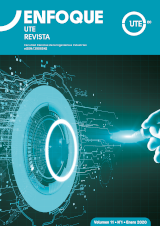Alternative Under Frecuency Load Disconection Methodology Based on Semi-Adaptative Model
DOI:
https://doi.org/10.29019/enfoque.v11n1.587Keywords:
Load disconnection, Load shedding, Power system stability, System frequency response, Under Frequency Load SheddingAbstract
Stability analysis in electrical power systems is based on the study in dynamic state of the voltage and frequency, since at the moment that there is some contingency it fluctuates drastically due to the primary and secondary controls of the voltage and frequency to the power systems that act on the generators. In order to solve the possible stability problems that may arise in power systems, various techniques have been developed that act on the generating machines for their protection as well as on the loads for the power cut. The present investigation proposes an alternative methodology for load disconnection by low frequency as an option to save the power system from a possible blackout due to instability due to a fall in the frequency, managing to improve the results affected by other improved techniques, the frequency change range, frequency deviation and the effects of demand disconnection. The proposed methodology was tested in the IEEE 14 bus system.
Downloads
References
Anderson, P. M., Fouad, A. A., & Happ, H. H. (1979). Power System Control and Stability. In IEEE Transactions on Systems, Man, and Cybernetics (Vol. 9). https://doi.org/10.1109/TSMC.1979.4310158
Arias, D., Vargas, L., & Rahmann., C. (2015). WAMS - Based Voltage Stability Indicator Considering Real Time Operation. Latin America Transactions, IEEE (Revista IEEE America Latina), 13(5), 1421–1428.
Carrión, D., Ayo, A., & Gonzalez, J. W. (2019). Under Frecuency Load Disconection Scheme Based on Improvement to Semi-Adaptative Model. 2019 International Conference on Information Systems and Computer Science (INCISCOS).
Carrion, D., & Gonzalez, J. W. (2018). Optimal PMU Location in Electrical Power Systems Under N-1 Contingency. 2018 International Conference on Information Systems and Computer Science (INCISCOS), (1), 165–170. https://doi.org/10.1109/INCISCOS.2018.00031
Carrión, D., & González, J. W. (2019). Ubicación óptima de PMU considerando restricciones de contingencias N-1 en sistemas eléctricos de potencia. Enfoque UTE, 10(1), 1–12. https://doi.org/10.29019/enfoqueute.v10n1.437
Carrión, D., González, J. W., Isaac, I. A., & López, G. J. (2017). Optimal Fault Location in Transmission Lines Using Hybrid Method. 2017 IEEE PES Innovative Smart Grid Technologies Conference, 6. https://doi.org/10.1109/ISGT-LA.2017.8126757
Carrion, D., Gonzalez, J. W., Isaac, I. A., Lopez, G. J., & Cardona, H. A. (2017). Load Characterization Based on Voltage and Current Phasorial Measurements in Micro-Grids. 2017 International Conference on Information Systems and Computer Science (INCISCOS), 1–6. https://doi.org/10.1109/INCISCOS.2017.23
Carrión, D., & Ortiz, L. (2013). Generación distribuida a partir de bicicletas estáticas y sistemas híbridos. Ingenius, 44–48.
Correa, E., Inga, E., Inga, J., & Hincapie, R. (2018). Electrical consumption pattern base on meter data management system using big data techniques. Proceedings - 2017 International Conference on Information Systems and Computer Science, INCISCOS 2017, 2017-Novem, 334–339. https://doi.org/10.1109/INCISCOS.2017.19
Guerrón, G., García, E., & Montero, A. (2014). Influencia de las ráfagas de viento en la calidad de la energía de los parques eólicos ( Influence of wind gusts in power quality on wind farms ). Enfoque UTE, 5(3), 25–44.
Inga Ortega, E., Inga, J., Correa, E., & Hincapié, R. (2018). Reconstrucción del patrón de consumo eléctrico a partir de Big Data mediante técnica de MapReduce. Enfoque UTE, 9(1), 177–187. https://doi.org/10.29019/enfoqueute.v9n1.220
Kundur, P. (1994). Power System Stability and Control (1ST editio). New York: McGraw-Hill Professional.
Kupzog, F. (2008). Frequency-Responsive Load Management in Electric Power Grids (1st Editio). Südwestdeutscher Verlag für Hochschulschriften.
Laghari, J. A., Mokhlis, H., Bakar, A., Halim, A. B., Karimi, M., & Shahriari, A. (2012). An Intelligent Under Frequency Load Shedding Scheme for Islanded Distribution Network. Power Engineering and Optimization Conference (PEDCO) Melaka, Malaysia, 2012 Ieee International, (June), 40–45.
Liu, B., & Thomas, D. (2011). ROCOF protection in distributed system with noise and non-linear load. 2011 10th International Conference on Environment and Electrical Engineering, EEEIC.EU 2011 - Conference Proceedings, 2–5. https://doi.org/10.1109/EEEIC.2011.5874715
Maldonado, M. G. R. (2017). Wireless Sensor Network for Smart Home Services Using Optimal Communications. 2017 International Conference on Information Systems and Computer Science (INCISCOS), 27–32. https://doi.org/10.1109/INCISCOS.2017.21
Massucco, S., & Delfino, B. (2001). Implementation and Comparison of Different Under Frequency Load-Shedding Schemes. Power Engineering Society Summer Meeting, 2001 (Volume:1 ), 307–312.
Mazaher, K., & Hazlie, M. (2014). Under-Frequency Load Shedding Scheme for Islanded Distribution Network (1st Editio). LAP Lambert Academic Publishing.
Perumal, I. N., & Ying, C. C. (2004). A Proposed Strategy of Implementation for Load Shedding and Load Recovery with Dynamic Simulations. Power and Energy Conference, 2004. PECon 2004. Proceedings. National, 185–189.
Ruiz, M., Masache, P., & Dominguez, J. (2018). High Availability Network for Critical Communications on Smart Grids. (Ssn), 1–5.
Ruiz Maldonado, M. G., & Inga, E. (2019). Asignación óptima de recursos de comunicaciones para sistemas de gestión de energía. Enfoque UTE, 10(1), 141–152. https://doi.org/10.29019/enfoqueute.v10n1.447
Schmitz, T. L., & Smith, K. S. (2009). Machining Dynamics: Frequency Response to Improved Productivity. New York: Springer.
Shafiullah, M., Alsharif, B. S., Hossain, M. I., & Ahsan, M. Q. (2014). Impact study on a load rich island and development of frequency based auto load shedding scheme to improve service reliability of the island. Informatics, Electronics & Vision (ICIEV), 2014 International Conference On.
Shokooh, F., Dai, J. J., Shokooh, S., Tastet, J., Castro, H., Khandelwal, T., & Donner, G. (2005). An Intelligent Load Shedding ( ILS ) System Application in a Large Industrial Facility. Industry Applications Conference, 2005. Fourtieth IAS Annual Meeting. Conference Record of the 2005 (Volume:1 ), 2(949).
Short, J. A., Infield, D. G., & Freris, L. L. (2007). Stabilization of Grid Frequency Through Dynamic Demand Control. Power Systems, IEEE Transactions on (Volume:22 , Issue: 3 ), 22(3), 1284–1293.
Systems, P., Committee, R., Power, I., & Society, E. (2007). IEEE Std C37.117TM-2007, IEEE Guide for the Application of Protective Relays Used for Abnormal Frequency Load Shedding and Restoration.
Ten, C. F., & Crossley, P. A. (2008). EVALUATION OF ROCOF RELAY PERFORMANCES ON NETWORKS WITH DISTRIBUTED GENERATION. Developments in Power System Protection, 2008. DPSP 2008. IET 9th International Conference On, 523–528.
Tofis, Y., Hadjidemetriou, L., & Kyriakides, E. (2013). An intelligent load shedding mechanism for maintaining frequency stability. PowerTech (POWERTECH), 2013 IEEE Grenoble, 1–5.
Zin, a. a. M., Hafiz, H. M., & Wong, W. K. (2004). Static and dynamic under-frequency load shedding: a comparison. 2004 International Conference on Power System Technology, 2004. PowerCon 2004., 1(November), 941–945. https://doi.org/10.1109/ICPST.2004.1460129
Published
How to Cite
Issue
Section
License
Copyright (c) 2020 Enfoque UTE

This work is licensed under a Creative Commons Attribution 3.0 Unported License.
The articles and research published by the UTE University are carried out under the Open Access regime in electronic format. This means that all content is freely available without charge to the user or his/her institution. Users are allowed to read, download, copy, distribute, print, search, or link to the full texts of the articles, or use them for any other lawful purpose, without asking prior permission from the publisher or the author. This is in accordance with the BOAI definition of open access. By submitting an article to any of the scientific journals of the UTE University, the author or authors accept these conditions.
The UTE applies the Creative Commons Attribution (CC-BY) license to articles in its scientific journals. Under this open access license, as an author you agree that anyone may reuse your article in whole or in part for any purpose, free of charge, including commercial purposes. Anyone can copy, distribute or reuse the content as long as the author and original source are correctly cited. This facilitates freedom of reuse and also ensures that content can be extracted without barriers for research needs.
This work is licensed under a Creative Commons Attribution 3.0 International (CC BY 3.0).
The Enfoque UTE journal guarantees and declares that authors always retain all copyrights and full publishing rights without restrictions [© The Author(s)]. Acknowledgment (BY): Any exploitation of the work is allowed, including a commercial purpose, as well as the creation of derivative works, the distribution of which is also allowed without any restriction.























 Enfoque UTE - Facultad de Ciencias de la Ingeniería e Industrias - Universidad UTE
Enfoque UTE - Facultad de Ciencias de la Ingeniería e Industrias - Universidad UTE